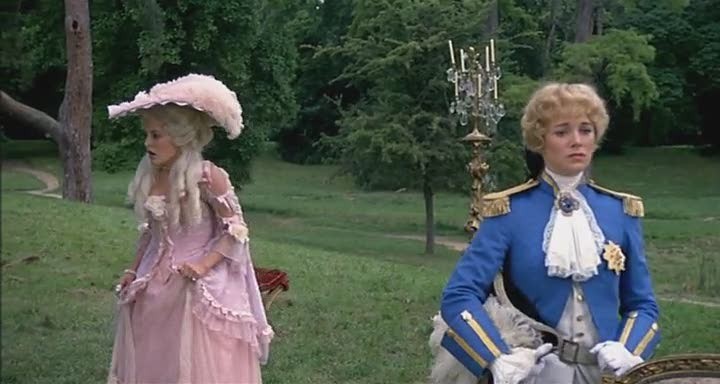
Paul Zahl continues his look at Lady Oscar, an undervalued film by Jacques Demy:
HER ODD BEAUTY
First,
it is lovely to look at. There is not a bad or ugly composition in it,
for a master is directing the camera. As always with Demy, there is
the iris effect at the beginning and the end; the women's fashions are
gorgeous; the lens is fluid but not falsely fluid. (I love the Vertigo
effect, half-way through, when Marie Antoinette finally succumbs to her
“youthful passion” in the garden pavilion. It doesn't feel out of place
at all.) The ball sequences are fairy tales of movement and pastels,
especially blues; the outdoor scenes at the Queen's Versailles hameau
or retreat are pure “70s pastoral”, soft-focus, but not like
advertisements; and the actors, who are mostly wooden, fit when you
understand they are meant to be decoration for . . . “Lady Oscar”.
Now I come to the two chief goods of this film,
which leaves, with its many faults — such as the woodenness of the
plot, the script, and the actors, to name just a few! — a lasting impression.
The first great plus of Lady Oscar is the
“gender-bending” situation of the main story. “Lady Oscar”, a daughter born
to a noble mother after five girls have preceded her in birth, has been raised a boy. Oscar is a beautiful young woman in the
garb and robe of a young man. But Oscar knows she is really a girl, and
understands herself to be a girl. Nevertheless, she plays
the part of and dresses like a man, in order to please her father (who
had tired of having so many daughters, and longed for a son).
There
is no sub-text here, in other words, or at least none that I
can see. When Oscar takes off her shirt, for example, to examine her
body after a duel, we see her female chest. Demy dwells on Catriona
MacColl in this scene. Later, she is able to confess her lifelong love
for 'André' to André, and they make love. There is no ambiguity or
ambivalence.
Yet,
and I think it is an important “yet”, “Lady Oscar's”
role-playing, her male clothing over a woman's body, gives her insight and involvement in
the life of both the sexes at Court. We therefore see the highest world of female fashion,
through the eye of the Queen's Body Guard, “Oscar”, who is a woman. Maybe
this reflects Jacques Demy's own persona. I don't know. He certainly
shows, in the stunning visuals and moving camera, a secure comfort with
the material.
Whatever is going on under the surface, or
psycho-dynamically, on
which we might have more light to shed today, what you actually see in
the movie is the tale of a yearning female adult who is doing her duty
(and performing it well) as a cross-dresser, yet never stops loving . . . André.
Now to the second and final point, the core of “Lady Oscar for Today”. A
theme I see again and again in the films of Jacques Demy is the
contrast between private domestic intimate drama, between individuals;
and the bigger social and political struggles that surround people at
points of history. Thus, in The Young Girls of Rochefort (1967), the
romantic longings of the twins, played by Catherine Deneuve and Françoise
Dorléac, are lightly contrasted with readings
from the newspaper, by their mother, concerning threats to world peace. In A Room in Town (1988) the fated
romance of Dominique Sanda and Richard Berry is played out against the
background of a shipbuilders' strike in a French port. The
focus is on the intimate drama, not on the social conflict; and that is
reflected concretely and bitterly at the end.
scenes, such historic events as the first meeting of the Estates General
and the fall of the Bastille, the director's focus, almost
against the screenplay, is on “André” and “Oscar”. That relationship is
where your emotional attention is, from the beginning to the end. And
the ending of the movie reflects this personal focus most
acutely, and painfully, and memorably. No wonder almost everyone
deplores the ending. I can well understand why. Nevertheless, I love
the ending. Mainly because I can't shake it. I wake up sometimes
thinking about it, crying out “André!” and waking our neighbor's dog,
not to mention Mary.
The ending of Lady Oscar says something
important about life. The “devil is in the details”, or rather, the
heart of life is in the personal — the intimate, the one-to-one, the
“hopes and dreams of all the years” . . . in a gently crying child, in
a
mourned romantic love, in a blue-and-red uniform of the Queen's Guards,
with a lovely actress secure within it, looking not for “Liberté!
Fraternité! Égalité!” (which are wonderful ends,
we know), but rather for the stable boy of her heart, the man whose heart
never left her and whose heart she never left.
